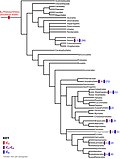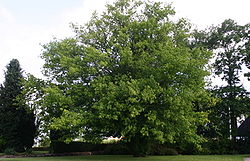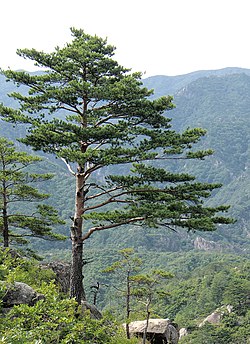The basal angiosperms are the flowering plants which diverged from the lineage leading to most flowering plants. In particular, the most basal angiosperms...
7 KB (655 words) - 21:02, 26 March 2025
basal clade of extant angiosperms, consisting of the most species, genus, family and order within the group that are sister to all other angiosperms (out...
36 KB (3,972 words) - 03:13, 2 June 2025
Flowering plant (redirect from Angiosperms)
angiosperms diversified explosively, becoming the dominant group of plants across the planet. Agriculture is almost entirely dependent on angiosperms...
82 KB (6,448 words) - 22:51, 16 June 2025
Asterids (redirect from Basal lamiids)
(sometimes called Laminae). The remainder of the lamiids are referred to as "basal lamiids", in which Garryales is the sister group to the core lamiids. It...
9 KB (673 words) - 07:58, 24 May 2025
Dicotyledon (category Historically recognized angiosperm taxa)
such as the magnoliids and groups now collectively known as the basal angiosperms, diverged earlier than the monocots did; in other words, monocots...
14 KB (800 words) - 16:58, 16 June 2025
Mesangiospermae (redirect from Core angiosperms)
contains the majority of flowering plants (angiosperms). Mesangiosperms are therefore known as the core angiosperms, in contrast to the three orders of earlier-diverging...
12 KB (1,182 words) - 02:18, 20 April 2025
Austrobaileyales (category Angiosperm orders)
commonly known as star anise. The order belongs to the group of basal angiosperms, the ANA grade (Amborellales, Nymphaeales, and Austrobaileyales),...
6 KB (482 words) - 23:17, 19 May 2025
collaborate to establish a consensus on the taxonomy of flowering plants (angiosperms) that reflects new knowledge about plant relationships discovered through...
33 KB (3,527 words) - 15:26, 7 March 2025
angiosperms include magnoliids and what are sometimes referred to as basal angiosperms or paleodicots, but these terms have not been widely or consistently...
16 KB (1,459 words) - 15:57, 26 May 2025
Nymphaeaceae (category Angiosperm families)
dispersed than other basal angiosperms. Nymphaeaceae is placed in the order Nymphaeales, which is the second diverging group of angiosperms after Amborella...
28 KB (2,799 words) - 15:11, 26 May 2025
The same is supposed for some other basal angiosperms. It is believed that early in the development of angiosperm lineages, there was a duplication in...
13 KB (1,596 words) - 04:29, 9 May 2025
Amborella (category Angiosperms)
Arabidopsis thaliana, and the basal angiosperms Amborella, Nuphar (Nymphaeaceae), Illicium, the monocots, and more derived angiosperms (eudicots), chloroplast...
28 KB (2,908 words) - 10:32, 8 June 2025
early branching basal grade, the basal angiosperms (ANA grade) with three lineages and a larger late branching grade, the core angiosperms (mesangiosperms)...
116 KB (11,156 words) - 17:00, 9 June 2025
(November 2000). "New Perspectives on the Pollination Biology of Basal Angiosperms". International Journal of Plant Sciences. 161 (S6): S225 – S235....
90 KB (9,302 words) - 18:33, 22 May 2025
Nymphaeales (category Angiosperm orders)
the Nymphaeaceae (water lilies). It is one of the three orders of basal angiosperms, an early-diverging grade of flowering plants. At least 10 morphological...
20 KB (1,566 words) - 07:29, 2 June 2025
APG IV system (category Angiosperm Phylogeny Group)
modern, mostly molecular-based, system of plant taxonomy for flowering plants (angiosperms) being developed by the Angiosperm Phylogeny Group (APG). It...
40 KB (2,558 words) - 15:03, 19 September 2024
Rosales (category Angiosperm orders)
divided into three clades that have never been assigned a taxonomic rank. The basal clade consists of the family Rosaceae; another clade consists of four families...
12 KB (1,058 words) - 13:08, 25 May 2025
Fabales (category Angiosperm orders)
of flowering plants included in the rosid group of the eudicots in the Angiosperm Phylogeny Group II classification system. In the APG II circumscription...
6 KB (562 words) - 10:02, 22 September 2024
regnans, allegedly grew to a height of 140 metres, the tallest living angiosperms are significantly smaller at around 100 metres.) The thickest (that is...
49 KB (5,832 words) - 10:47, 5 June 2025
plants, containing about 70,000 species, more than a quarter of all angiosperms. The clade is divided into 16 to 20 orders, depending upon circumscription...
13 KB (1,030 words) - 07:29, 15 May 2025
of the angiosperms. However, the occurrence of vessel elements is not restricted to angiosperms, and they are absent in some archaic or "basal" lineages...
54 KB (6,796 words) - 03:46, 1 June 2025
the lycophytes is reproduced below (with some branches collapsed into 'basal groups' to reduce the size of the diagram). In this view, the "zosterophylls"...
16 KB (1,449 words) - 02:12, 12 March 2025
Sapindales (category Angiosperm orders)
Society. 181: 1–20. doi:10.1111/boj.12385. Angiosperm Phylogeny Group III (2009). "An update of the Angiosperm Phylogeny Group classification for the orders...
5 KB (407 words) - 02:32, 13 November 2024
Solanales (category Angiosperm orders)
following families are included here in newer systems such as that of the Angiosperm Phylogeny Group (APG): Family Solanaceae (nightshade family; includes...
4 KB (344 words) - 18:38, 23 April 2025
clubmosses, horsetails, ferns, gymnosperms (including conifers), and angiosperms (flowering plants). They are contrasted with nonvascular plants such...
24 KB (2,102 words) - 22:03, 15 June 2025
thought to be most closely related to them, but molecular evidence supports a basal position in the family. The five taxa of Cedrus are assigned according to...
14 KB (1,464 words) - 05:30, 2 June 2025
axil of a scale leaf. These bud scales often remain on the fascicle as a basal sheath. The needles persist for 1.5–40 years, depending on species. If a...
74 KB (5,126 words) - 01:48, 18 June 2025
Caryophyllales (category Angiosperm orders)
sister to the asterid clade. The possible connection between sympetalous angiosperms and Caryophyllales was presaged by Bessey, Hutchinson, and others; as...
11 KB (1,063 words) - 00:30, 19 May 2025
Ericales (category Angiosperm orders)
Majure, Lucas; Mavrodiev, Evgeny (2018). Phylogeny and Evolution of the Angiosperms (p. 262). University of Chicago Press. Kindle Edition. LCCN 2016046547...
14 KB (1,074 words) - 20:21, 23 May 2025
paraphyletic grouping of early-branching taxa known collectively as the basal angiosperms, plus the families Ceratophyllaceae and Chloranthaceae.[citation needed]...
15 KB (1,692 words) - 16:57, 3 April 2025




























